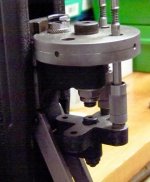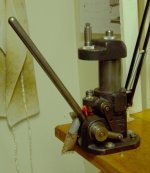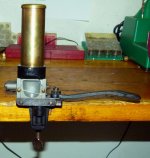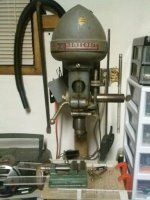My reloading press is a Hollywood Universal. It has twelve loading stations and can hold four different case holders. It had some .308 dies on it when this picture was taken. There are two dies I keep on it permanently; one is a Vickerman 30 caliber bullet seater and the other is a Forster bullet puller, the blue finish die. It's particularly convenient when loading straight cased ammo such as pistol ammo that has to be sized and expanded in separate operations; a click of the head from one die to the other and the job is done. Unfortunatly it's not usable with the RCBS primer pocket swadger.
The press has been around a while; the close up shows the priming mechanism which has arms installed for large and small primers. The two empty stations show the age of the press; at that time primers were only available from Remington and Winchester-Western (and FA 70 large rifle primers form Frankfort Arsenal). Up until the 1950s, I think, Remington primers had flat cups while Winchester-Western were slightly domed, and priming arms were made to fit both shapes of primers.
The other press is a Hollywood Senior. I don't do much reloading on it; it's usually set up for decapping. Neither the Universal nor the Senior have any arrangement for catching spent primers; I made a sort of kluge on the Senior to catch spent primers in the plastic bag. I also use it with file type case trimmers; they're a lot easier to use on the Senior than the Universal.
The powder measure looks like a Belding & Mull Visible Powder Measure. It isn't; it was made by Harpster & Williams in Phillipsburg, PA. They designed and produced the measure; Belding & Mull needed a measure in their line-up and bought the design from Harpster & Williams. Like most of these, the glass window is cracked. I have replaced these with clear plastic but haven't done it on this one yet The measure was originally designed for black powder and the brass and iron consturction prevent the build-up of static electricity. I also have a RCBS Little Dandy and a RCBS electronic scale and measure, but these are largely plastic and RCBS advises they're not suitable for black powder.
Let's see the antique equipment you're using.
The press has been around a while; the close up shows the priming mechanism which has arms installed for large and small primers. The two empty stations show the age of the press; at that time primers were only available from Remington and Winchester-Western (and FA 70 large rifle primers form Frankfort Arsenal). Up until the 1950s, I think, Remington primers had flat cups while Winchester-Western were slightly domed, and priming arms were made to fit both shapes of primers.
The other press is a Hollywood Senior. I don't do much reloading on it; it's usually set up for decapping. Neither the Universal nor the Senior have any arrangement for catching spent primers; I made a sort of kluge on the Senior to catch spent primers in the plastic bag. I also use it with file type case trimmers; they're a lot easier to use on the Senior than the Universal.
The powder measure looks like a Belding & Mull Visible Powder Measure. It isn't; it was made by Harpster & Williams in Phillipsburg, PA. They designed and produced the measure; Belding & Mull needed a measure in their line-up and bought the design from Harpster & Williams. Like most of these, the glass window is cracked. I have replaced these with clear plastic but haven't done it on this one yet The measure was originally designed for black powder and the brass and iron consturction prevent the build-up of static electricity. I also have a RCBS Little Dandy and a RCBS electronic scale and measure, but these are largely plastic and RCBS advises they're not suitable for black powder.
Let's see the antique equipment you're using.







